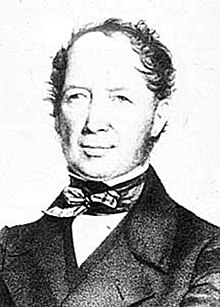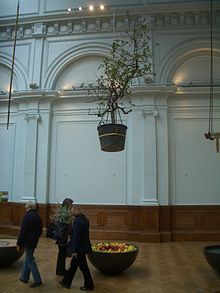John Lindley (botanist)
John Lindley (born February 5, 1799 in Old Catton , Norfolk , † November 1, 1865 in Acton Green , Middlesex ) was an English botanist . Its official botanical author's abbreviation is “ Lindl. "As the first botanist Lindley created a classification of orchids and so is considered the father of modern orchidology.
Lindley's opinion on the Irish situation was instrumental in rejecting the Corn Laws .
Live and act
Lindley was the eldest of four children of gardener George Lindley (approx. 1769-1835) from Yorkshire and his wife Mary, nee Moore. His father was a pomologist and had written a horticultural manual ( A Guide to the Orchard and Kitchen Garden ). Already in his school days at the high school in Norwich John Lindley collected wild plants, but also antiquities, his nickname was "Old Antiquity". He wanted to become a soldier, but the family could not find the money to buy him an officer's license . In 1815 he became a traveler for the seed dealer Wrench of Camberwell and then spent some time at home doing entomological studies until his father got into economic difficulties.
In 1817 he met William Jackson Hooker , a then well-known botanist, who was based in Norwich, and stayed in touch with him even after his move to Halesworth . Through Hooker he became known to Charles Lyell and Robert Brown . Through Brown's mediation, he became assistant librarian at Joseph Banks in Soho in 1819 , who made him hope that he would go on research trips for him. He looked after the library and herbarium ; after the death of Banks he completed the works he left behind. From 1821, after the death of Banks, Lindley received massive support from the merchant and orchid collector William Cattley (1788-1835). In 1821 he published his Collectanea Botanica . After this he named the genus Cattleya Lindl in 1824 . With the money Lyell had given him, Lindley bought a microscope and a small herbarium.
In 1822, Lindley was assistant secretary of the Royal Horticultural Society (RHS), then a notable figure in the botanical world, and was so also with the supervision of horticultural activities for William Cavendish, 6th Duke of Devonshire (1790-1858), on his country estate Chiswick entrusted. He organized the first RHS garden exhibition there. Lindley determined the plants that the company received from the collectors. In 1832 he was at the University of Munich as a doctor of philosophy doctorate .
In 1823 Lindley married Sarah Freestone (1791–1869), the daughter of Anthony George Freestone. The couple lived in Acton Green and had five children, but otherwise Lindley appears to have neglected his wife in favor of his plants. His draftsman Sarah Drake , who became famous as an orchid painter, also lived in the house between 1830 and 1847 . In 1840 he named the Australian orchid genus Drakea after her. His daughters also created illustrations for his works. He often took his eldest daughter to social events in place of his wife.
Since Lindley had to stand up for his father's debts, he suffered from financial difficulties throughout his life and was constantly looking for new sources of income. In 1829 Lindley became professor of botany at University College London , a position he held until his retirement in 1861. In 1835 he published the work Natural System of Botany, in which he divided the orchids into seven tribes .
In 1841, Lindley, Joseph Paxton, and others founded The Gardeners' Chronicle, a horticultural journal . This journal would become one of the excellent vehicles for promoting orchid science. Through his ties to the Royal Horticultural Society and wealthy patrons, Lindley became an expert on orchids in England and Europe . In this position he received many new plants for identification and description, published many new descriptions and fundamental investigations and laid a broad basis for scientific orchid science. In October 1845, Lindley and the chemist Lyon Playfair traveled to Ireland on behalf of Robert Peel , the British Prime Minister, to investigate the local famine , the potato rot and the effects of the Corn Laws. He stressed the extent of the disaster and the need for relief efforts.
As a result of working on his herbaria, Lindley probably suffered from mercury poisoning , which greatly diminished his creativity in old age. He died of a stroke in Acton Green on November 1, 1865 and was buried in Acton.
Honors
In 1820 he was elected a member of the Leopoldina . In 1828 Lindley was elected a member of the Royal Society , which in 1857 awarded him the Royal Medal . Since 1834 he was a corresponding member of the Prussian and since 1840 of the Bavarian Academy of Sciences . In 1853 he was accepted as a corresponding member of the Académie des sciences . The RHS named its 1904 exhibition hall on Elverton Street in Chelsea in his honor. In 1859 he was elected to the American Academy of Arts and Sciences .
The following plant genera were named after him: Lindleya Nees (1821, nom. Rej.), Lindleya Kunth (1824, nom. Cons.), Neolindleya Kraenzl. (1899) Lindleyella Rydb. (1908), Lindleyella Schltr. (1914, nom. Illeg.), Neolindleyella Fedde (1940), Lindleyara Garay & HR Sweet (1966) and Lindleycladus T.M. Harris (1979). In addition, the epithet of numerous plant species refers to Lindley's name.
Fonts (selection)
- Rosarum Monographia. Or a Botanical History of Roses, to which is added an Appendix for the Use of Cultivators, in which the most remarkable Garden Varieties are systematically arranged. Ridgway, London 1820.
- Digitalium Monographia. Sistens historiam botanicam Generis, Tabulis omnium Specierum hactenus cognitarum illustratam, ut plurimum confectis ad icones Ferdinandi Bauer penes Gulielmum Cattley. Bohte, London 1821.
- A Synopsis of the British Flora. Arranged according to the natural orders: Containing Vasculares, or flowering Plants. Longman, Rees, Orme, Brown, Green, London 1829 (second edition ibid. 1835; 3rd edition ibid. 1841).
- The Genera and Species of Orchidaceous Plants. Ridgway, London 1830-1840.
- An Introduction to the natural System of Botany: or, A systematic View of the Organization, natural Affinities, and geographical Distribution, of the whole vegetable Kingdom; Together with the Uses of the Most Important Species in Medicine, the Arts, and Rural or Domestic Economy. Longman, Rees, Orme, Brown, and Green, London 1830 ( biodiversitylibrary.org ).
- John Lindley and William Hutton, Fossil Flora of Great Britain, or figures and descriptions of vegetal remains found in a fossil state in this country. James Ridgway, London 1831-1837.
- Nixus Plantarum. Ridgway, London 1833 ( Text Archive - Internet Archive ).
- Sertum Orchidaceum. A Wreath of the Most Beautiful Orchidaceous Flowers. Ridgway, London 1837-1841.
- Pomologia Britannica or, Figures and descriptions of the most important varieties of fruit cultivated in Great Britain. HG Bohn, London 1841 ( biodiversitylibrary.org ).
literature
- The late Dr. John Lindley, FRS, FLS In: The Journal of Botany, British and Foreign. Volume 3, 1865, pp. 384-388 ( biodiversitylibrary.org ).
- FW Oliver (Ed.): Makers of British botany. A collection of biographies by living botanists. Cambridge University Press, Cambridge 1913, pp. 164-177 ( biodiversitylibrary.org ).
- Richard Drayton: Lindley, John (1799-1865). In: Henry Colin Gray Matthew, Brian Harrison (Eds.): Oxford Dictionary of National Biography , from the earliest times to the year 2000 (ODNB). Volume 33: Leared-Lister. Oxford University Press, Oxford 2004, ISBN 0-19-861383-0 , ( oxforddnb.com license required ), as of May 2009, accessed October 15, 2013.
- William Thomas Stearn (Ed.): John Lindley, 1799-1865: Gardener-Botanist and Pioneer Orchidologist. Antique Collectors Club Limited, Woodbridge 1999, ISBN 1-85149-296-8 .
Web links
- Author entry and list of the plant names described for John Lindley (botanist) at the IPNI
- Lindley, John (1799–1865) In: anbg.gov.au. Australian National Herbarium, April 2, 2015
Individual evidence
- ↑ Sue Minter: The Apotecaries' Garden. Stroud 2010, p. 47.
- ↑ The late Dr. John Lindley, FRS, FLS In: The Journal of Botany, British and Foreign. Volume 3, 1865, p. 384.
- ↑ a b Richard Drayton: Lindley, John (1799-1865). In: Henry Colin Gray Matthew, Brian Harrison (Eds.): Oxford Dictionary of National Biography , from the earliest times to the year 2000 (ODNB). Volume 33: Leared-Lister. Oxford University Press, Oxford 2004, ISBN 0-19-861383-0 , ( oxforddnb.com license required ), as of May 2009, accessed October 15, 2013.
- ↑ The late Dr. John Lindley, FRS, FLS In: The Journal of Botany, British and Foreign. Volume 3, 1865, p. 384 f.
- ↑ a b The late Dr. John Lindley, FRS, FLS In: The Journal of Botany, British and Foreign. Volume 3, 1865, p. 385.
- ↑ The late Dr. John Lindley, FRS, FLS In: The Journal of Botany, British and Foreign. Volume 3, 1865, p. 388.
- ↑ The late Dr. John Lindley, FRS, FLS In: The Journal of Botany, British and Foreign. Volume 3, 1865, p. 387.
- ^ Peel's proposals on the Corn Laws (1845). In: historyhome.co.uk. March 4, 2016, accessed March 7, 2017.
- ^ List of members since 1666: Letter L. Académie des sciences, accessed on January 14, 2020 (French).
- ↑ Lotte Burkhardt: Directory of eponymous plant names - Extended Edition. Part I and II. Botanic Garden and Botanical Museum Berlin , Freie Universität Berlin , Berlin 2018, ISBN 978-3-946292-26-5 , doi: 10.3372 / epolist2018 .
| personal data | |
|---|---|
| SURNAME | Lindley, John |
| BRIEF DESCRIPTION | English botanist |
| DATE OF BIRTH | February 5, 1799 |
| PLACE OF BIRTH | Old Catton , Norfolk |
| DATE OF DEATH | November 1, 1865 |
| Place of death | Acton Green , Middlesex |

